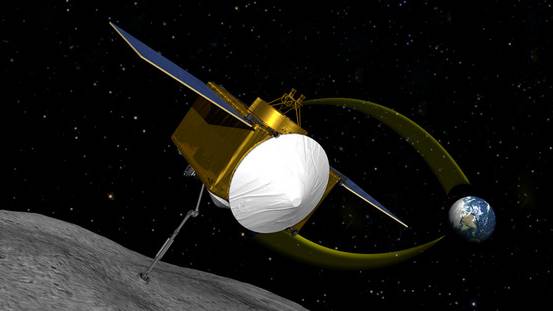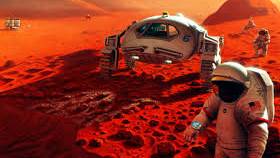The OSIRIS REX: NASA Chooses Threatening Asteroid for New Mission
Source: space.com
When it comes to visiting asteroids, NASA doesn’t pick run-of-the-mill space rocks. The target of NASA’s latest asteroid mission is not only thought to be rich in the building blocks of life, it also has a chance — although a remote one — of threatening Earth in the year 2182.The asteroid 1999 RQ36 is the target of a new unmanned spacecraft, which NASA plans to launch in 2016 to collect a sample from the space rock and return it to Earth by 2023.
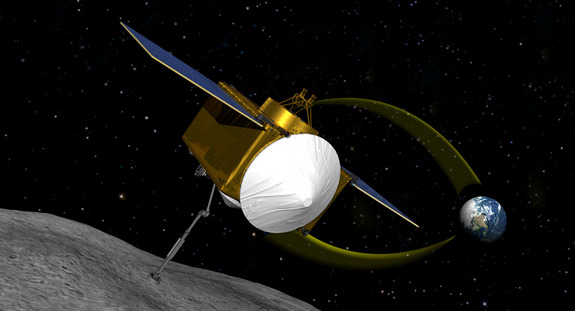
An artist’s interpretation of NASA’s asteroid-sample mission OSIRIS-REx, which will rendezvous with the near-Earth asteroid designated 1999 RQ36 in 2020. The mission is expected to launch in 2016.
CREDIT: NASA/Goddard/University of Arizona
The mission’s leaders spent a long time surveying possible destinations for the mission, and finally settled on 1999 RQ36. NASA calls the mission OSIRIS-Rex, which is short for Origins-Spectral Interpretation-Resource Identification-Security-Regolith Explorer.
"We went through a whole series of selection criteria," OSIRIS-Rex’s deputy principal investigator Dante Lauretta, a planetary scientist at the University of Arizona, told SPACE.com. "There are over 500,000 asteroids known. [1999 RQ36] looks really optimum."
A potentially dangerous asteroid
In addition to digging up clues about our solar system’s history, the OSIRIS-Rex mission may be able to help Earth fend off potentially deadly space rocks. That’s because asteroid 1999 RQ36 — which is about 1,900 feet (580 meters) wide — is public enemy No. 1 for space rock scientists.
"1999 RQ36 has the highest probability of impacting the Earth of any known Potentially Hazardous Asteroid," according to a mission proposal submitted to NASA by the OSIRIS-Rex in 2009.
A recent calculation found that the asteroid has a 1-in-1,800 chance of hitting Earth in the year 2170, and a 1-in-1,000 chanceof slamming into us in 2182.
While those are slim odds, they put 1999 RQ36 at the top of the danger list.
"I wouldn’t go buy asteroid insurance," Lauretta said. "We’re OK for 150 years or so. We’re not saving the Earth from immediate danger."
Still, he said studying the asteroid and its orbit up close could help us better predict the risk, and outline a strategy to protect ourselves if necessary.
One reason the likelihood of Earth impact can’t be better predicted is because scientists don’t fully understand the Yarkovsky effect, which causes asteroids to accelerate slightly when they absorb sunlight and then re-emit it as heat.
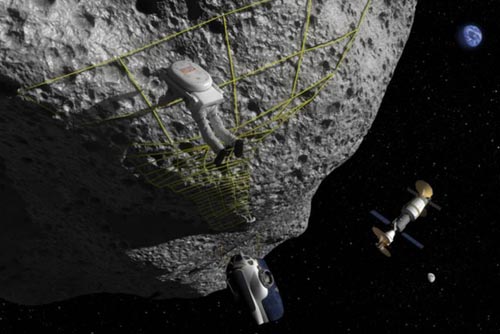
Artist’s concept of anchoring to the surface of an asteroid.
CREDIT: NASA
"[1999 RQ36’s] orbit is currently well known because of optical and radar data but the long-term motion is less well understood because of the poorly defined Yarkovsky effect," said Donald Yeomans, manager of NASA’s Near-Earth Object Program Office, who is not directly involved with the OSIRIS-Rex mission. "This mission should allow a much better understanding of these effects once the asteroid’s size, mass, rotation characteristics and thermal properties are studied."
Target: Asteroid 1999 RQ36
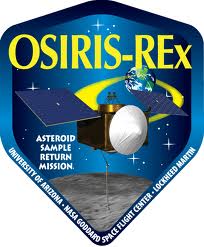 One of the most attractive features of asteroid 1999 RQ36 for scientists is its size: It is as large as five football fields, which means it won’t be spinning too fast when OSIRIS-Rex approaches. The asteroid should also have a large supply of lose dirt, or regolith, on its surface for easy sampling.
One of the most attractive features of asteroid 1999 RQ36 for scientists is its size: It is as large as five football fields, which means it won’t be spinning too fast when OSIRIS-Rex approaches. The asteroid should also have a large supply of lose dirt, or regolith, on its surface for easy sampling.1999 RQ36 is thought to be carbonaceous, or rich in carbon and organic material, and likely to contain some of the building blocks of life, such as the amino acids used to build the proteins vital to life on Earth.
"We cannot tell from telescopes exactly what kind of material, but we believe it’s the sort of stuff that came in through the Earth’s atmosphere after liquid oceans first formed, perhaps by 4.45 billion years ago, and provided those building blocks," said OSIRIS-Rex principal investigator Mike Drake of the University of Arizona, during a news conference yesterday (May 25).
In fact, the asteroid is a primitive B-class carbonaceous asteroid, a class that has never been studied up close by a spacecraft before, and should provide an unprecedented opportunity to learn about the history of the solar system and the origin of life on Earth.
The material inside 1999 RQ36 is thought to date to the very formation of our solar system around 4.56 billion years ago. While the space rock now orbits relatively near Earth — making it a convenient target for visiting — scientists think it is a fragment of an even larger asteroid that collided with another rock in the main asteroid belt between Mars and Jupiter, a few million years ago.
Building on asteroid successes
The OSIRIS-Rex mission is not NASA’s first mission to an asteroid, but it will be the first U.S. probe to retrieve samples and return them to Earth. Only Japan’s Hayabusa spacecraft, which returned samples of the asteroid Itokawa to Earth in June 2010 after a seven-year journey, has performed a similar feat.
[...]
Read the full article at: space.com
Video from: YouTube.com
OSIRIS:
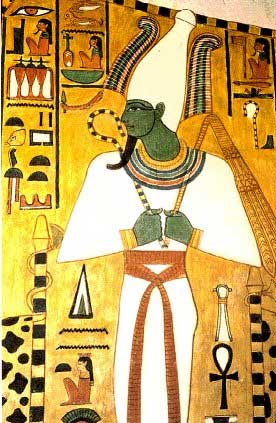 Other Names: Oser, Aser, Asar, Usire Patron of: the Underworld, the dead, past Pharaohs, agriculture (old form), fertility (old form).
Other Names: Oser, Aser, Asar, Usire Patron of: the Underworld, the dead, past Pharaohs, agriculture (old form), fertility (old form).Appearance: In his original form, a green-skinned man dressed in the raiment of a pharaoh. Following the Legend of Osiris, he appears as a green-skinned man in the form of a mummified pharaoh. He is often depicted wearing the atef crown with a pair of ram horns at its base.
Description: Throughout the height of Egyptian civilization, Osiris was the primary deity. In power, he was second only his father, Ra, and was the leader of the gods on earth. He was the husband of Isis and the father of Horus (and a number of other gods in some stories). Osiris resided in the underworld as the lord of the dead, as after being killed by Set, even though he was a god, he could no longer dwell in the land of the living.
After Osiris was killed, Isis resurrected him with the Ritual of Life, which was later given to the Egyptians so that they could give eternal life to all their dead. The spells and rituals cast by Isis, plus many others given to the people by the gods over the centuries, were collected into The Book of Going Forth by Day, colloquially known as The Book of the Dead.
In the underworld, Osiris sits on a great throne, where he is praised by the souls of the just. All those who pass the tests of the underworld become worthy to enter The Blessed Land, that part of the underworld that is like the land of the living, but without sorrow or pain. In some texts, in addition to the Judging of the Heart, Osiris passes final judgment over the dead, acting in this capacity as an Egyptian version of Radamanthus.
There is an interesting parallel between Osiris, a fertility/agriculture god, and the Greek Persephone, an agriculture goddess. Both end up in the underworld through treachery and both are kept there by "legal loopholes" in the laws of the gods. Persephone remains in the underworld for half a year because she tasted the food of the dead. Osiris remains in the underworld because Ma’at dictates that the dead, even dead gods, may not return to the land of the living.
Source
The Eye of Horus, Eye of Osiris
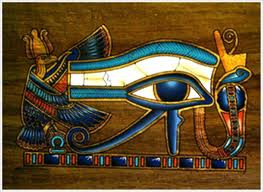
The Eye of Horus is known by many names: the Eye or Ra, the Eye of Osiris, the Eye of the Moon, or Wedjat.
In fact, Horus and Ra are two references of the same ancient Egyptian deity, while Osiris is Horus’ father. Horus (or Ra) was regarded as the Sun god, or the Sky god, and is said in legend to be half man - half falcon. The Eye of Horus is one of ancient Egypt’s most popular symbols, and hieroglyphic inscriptions of it are found in many archeological sites across Egypt. For example, several mummy tombs have been found to contain the Eye of Horus hieroglyphs.
Ancient Egyptians used different Eye of Horus artifacts as a way to protect and guide them in the Afterlife. It is also known as a symbol of protection and healing.
Other uses of the Eye of Horus in ancient Egypt include architecture as well as fashion. Apparently the proportions of the Eye are not coincidental, and were used as a sort of protractor. All the while, ancient Egyptian monarch wore the Eye as a symbol of status and of legitimacy. Modern versions of these charms often display the Eye centered in the middle of a Pyramid, with sunrays radiating from within it upwards.
The teardrop beneath the eye actually belongs to Hathor, Horus’ mother, who represents the galaxy itself.
Wearing the Eye of Horus charm is believed for several millenniums to foster protection and wisdom, as well as the ability to separate truth from lies.
Source
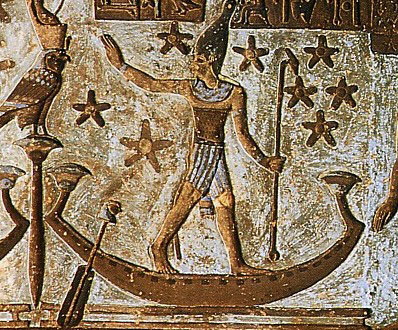
Also tune into:
Robert Temple - Egyptian Dawn & The Osiris Shaft
Steve Willner - Video Game Symbolism, Ciphers, Words & Movies
Edmund Marriage - The Shining Ones, Christian O’Brien, Zacharia Sitchin & Laurence Gardner
Antoine Gigal - Pyramids, Ancient Egypt, Boat Pits & The Flood
Richard C. Hoagland - Phobos an Ancient Alien Spaceship, Mars, NASA & Disclosure
Richard C. Hoagland - The Secret Space Program & The Fukushima Nuclear Reactor Disaster
Ralph Ellis - The Biblical Shepherd Kings & The Egyptian Hyksos Pharaohs
Peter Levenda - Secret Space Program & NASA’s Nazis
William Bramley - Gods of Eden, Alien Colonization & Eradication of Humanity
Richard Dolan - The Secret Space Program & Breakaway Civilization
